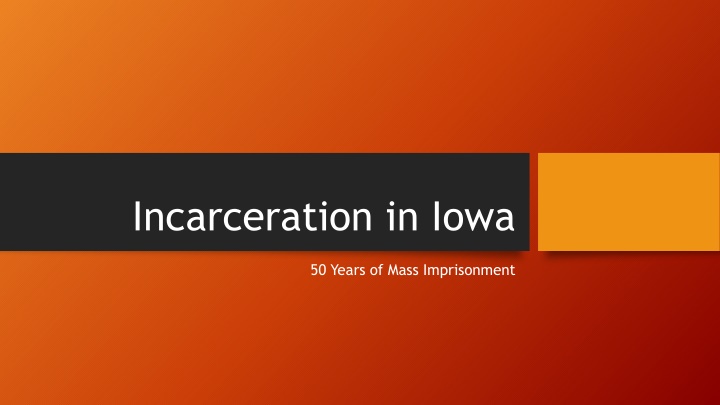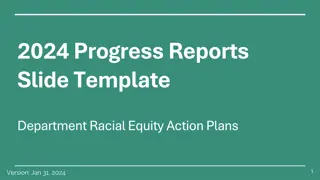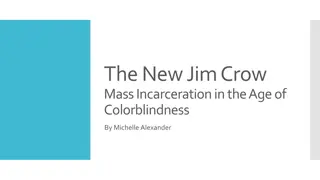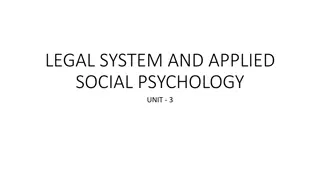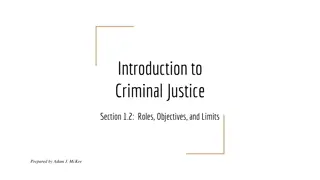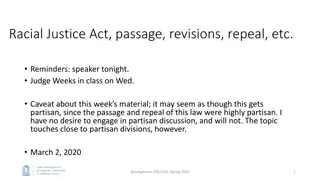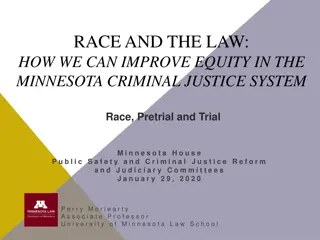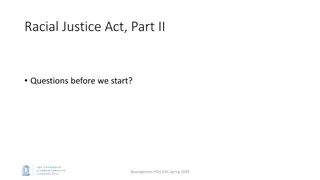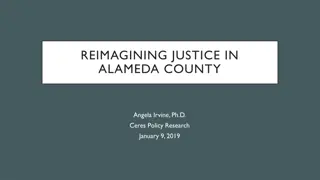Racial Disparities in Iowa's Criminal Justice System: A Deep Dive
Examine the stark racial disparities in Iowa's criminal justice system, spanning from incarceration rates to felony and misdemeanor convictions. Despite slightly lower per capita incarceration rates compared to the national average, Iowa faces significant challenges in addressing the overrepresentation of Black individuals in prisons and jails. The data reveals alarming disparities in arrests, felony convictions, and misdemeanor convictions, highlighting systemic inequities that persist within the state's criminal justice processes.
Download Presentation

Please find below an Image/Link to download the presentation.
The content on the website is provided AS IS for your information and personal use only. It may not be sold, licensed, or shared on other websites without obtaining consent from the author.If you encounter any issues during the download, it is possible that the publisher has removed the file from their server.
You are allowed to download the files provided on this website for personal or commercial use, subject to the condition that they are used lawfully. All files are the property of their respective owners.
The content on the website is provided AS IS for your information and personal use only. It may not be sold, licensed, or shared on other websites without obtaining consent from the author.
E N D
Presentation Transcript
Incarceration in Iowa 50 Years of Mass Imprisonment
Currently Incarcerated Persons 8,222 persons were in state prisons as of September, 2022 The Prison Population Initiative estimates that an additional 4,300 are incarcerated in jails, although that number changes daily. They also estimate that there are 3,700 Iowans serving in federal prisons. An additional 36,000 are under correctional control through probation or parole.
Iowa in Comparison Per capita incarceration rates are slightly lower than the national average -528/100,000 vs 572/100,000 However, the racial disparity in incarceration is one of the largest in the US: In 2022, Blacks represented 26.1 % of the adult prison population, vs. 3% of the state s population. This is an approximately 9 to 1 disparity! Only a few other states have disparities this large.
Racial disparities start with arrests and felony convictions Felony Convictions - 2014 and 2021 https://disposedcharges.iowa.g ov Total Felonies 2014 Total Felonies 2021 Black Hawk Dubuque Johnson Linn Polk Pottowatamie Woodbury 956 663 210 341 235 230 455 461 1,131 1,647 461 252 369 585 Black Felonies 2014 Black Felonies 2021 330 225 54 104 99 96 132 136 285 533 40 37 58 90 LatinX Felonies 2014 LatinX Felonies 2021 12 4 2 0 6 5 7 5 50 48 18 8 48 70 Percentage Black 2014 Percentage Black 2021 34.50% 33.90% 25.71% 30.50% 42.13% 41.74% 29% 25% 32% 8.46% 14.29% 15.70% 15.40% 29.50% Percentage LatinX 2014 Percentage LatinX 2021 1.30% 0.60% 0.95% 2.55% 2.17% 1.50% 1.10% 4% 3.90% 14.68% 13% 12% 0% 2.90% https://data.census.gov/cedsci / Total Population Percent Black Percent LatinX 131,144 10.70% unknown 99,266 3.80% 2.90% 152,854 8.40% unknown 230,299 492,401 7.20% 93,304 1.90% 8.70% 105,941 7% 4% 3.90%unknown unknown Felonies include classes A-D Include all genders and ages 18+
Disparities in Misdemeanor Convictions are a Front Door to the system Misdemeanor Convictions - 2014 and 2021 https://disposedcharges.iowa.go v Total Misdemeanors 2014 Total Misdemeanors 2021 Black Hawk Dubuque Johnson Linn Polk Pottowatamie Woodbury 4,389 3,972 4,179 3,944 6,507 3,816 7,243 5,927 11,260 10,259 1,068 969 4,668 3,892 Black Misdemeanors 2014 Black Misdemeanors 2021 1,614 1,486 769 1,964 1,375 1,906 1,714 2,591 2,759 78 110 456 625 1,143 LatinX Misdemeanors 2014 LatinX Misdemeanors 2021 82 30 36 42 171 84 92 63 456 419 33 50 514 500 Percentage Black 2014 Percentage Black 2021 36.80% 37.41% 18.40% 28.98% 30.18% 36.03% 26.30% 28.90% 23% 7.30% 11.35% 9% 16% 26.90% Percentage LatinX 2014 Percentage LatinX 2021 1.80% 0.07% 0.86% 1.06% 2.86% 2.20% 1.30% 1.10% 4% 4% 3.09% 5.16% 11% 12.80%
Trends in Iowa Incarceration In 1973, there were less than 2,000 persons in Iowa s state prisons. Iowa followed the national trend of rapid increases in the 70s, 80s and 90s. During the past ten years, the prison population has stayed within the 8,000 to 8,500 range except for dropping lower in the two pandemic years. Because of the absence of significant reform, imprisonment has not experienced the sharp drops occurring in some other states.
Seemingly conflicting trends Iowa prison admissions have dropped significantly over the last 10 years, in virtually all classes of felony, except for violent offenses and sexual offenses. Both imprisonment for new convictions and for returning to prison have decreased. However, there have been significant increases in the average length of stay: 18.1% for Class B. 19.4% for Class C 42.7% for Class D Thus, the size of the population can stay constant, despite fewer admissions.
Types of crimes resulting in imprisonment 35.6% are for felonies involving violence. 27.5% are for property crimes. 20.7% are for drug offenses. (Meth is most common one.) 15.3% are public order offenses. 0.9 % are other offeses.
Data Sources The Criminal and Juvenile Justice Planning division of the Iowa Department of Human Rights report Prison Population Forecast provides detailed breakdowns of incarceration. Their EZ Access to Adult and Juvenile Data files show arrests and convictions. The Prison Population Initiative breaks down incarceration by state. Sentencing Project data also reflects state breakdowns, in some cases.
